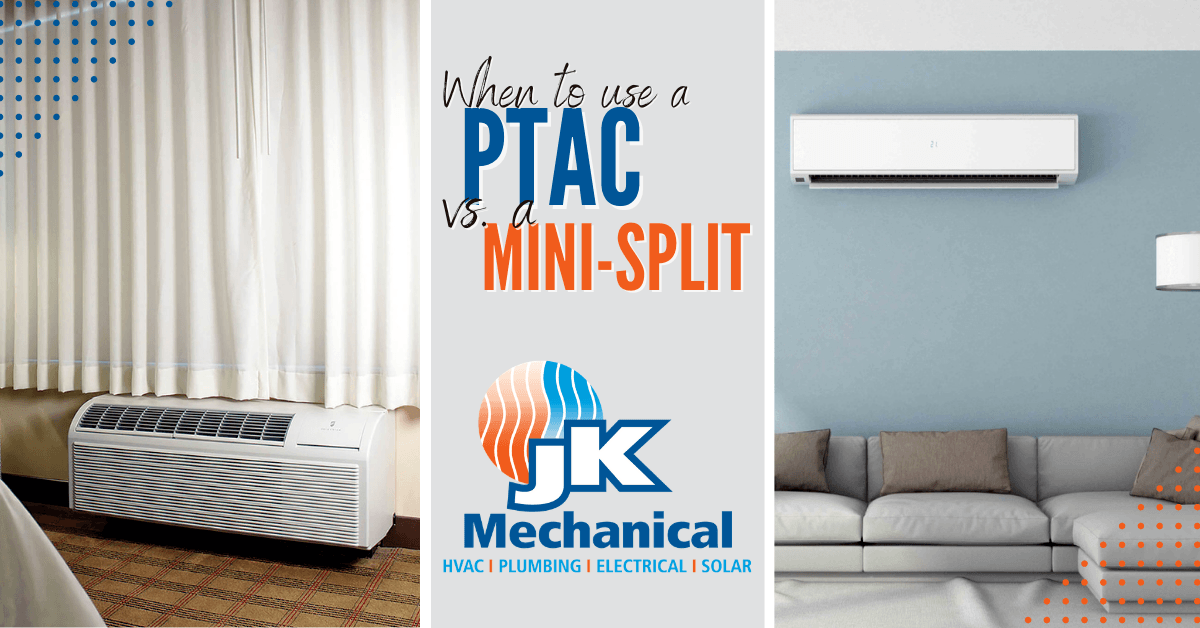When to use a PTAC vs a Mini-Split
Whether you are designing a new construction building or considering renovations, choosing the right ductless HVAC unit is an essential part of your plans and ultimately the resident or your client’s long-term comfort. If your application calls for a duct-free HVAC (or supplemental HVAC), your JK Mechanical consultant will often propose a PTAC or Mini Split unit. Read on to learn about the difference between these two types of equipment, and when each style might be a good choice for your project.
What is a PTAC?
First, we should define what a PTAC is! PTAC stands for “Packaged Terminal Air Conditioner.” PTACs are commercial grade HVAC units installed through a wall, usually near floor level. Don’t be misled by the name: PTACs are often “unitary” systems, meaning the single heat pump unit can provide both heating and cooling (sometimes referred to as a Packaged Terminal Heat Pump, or PTHP). In a PTAC/PTHP, the compressor pumps refrigerant through the system. The refrigerant attracts heat and moisture from indoors and then transfers it outdoors. Heat and moisture inside are removed when warm air passes over the cool indoor coil. The heat and humidity in the air are removed by the coil, thereby “cooling” the air indoors. When in heating mode, the reverse happens. Refrigerant is used to create a heated indoor coil. As air passes over the warm coil, the heat is transferred to the air inside the room.
What are the benefits of a PTAC?
- PTACs are compact in size, ranging from 42”x16” to 36”x15”. There is no “indoor unit” and “outdoor unit;” instead, you’re dealing with just the single through-the-wall model that will blend into your exterior façade.
- Certain models, such as the Amana EDEN control, can be individually operated in-room as well as centrally and wirelessly controlled from a central hub such as a front desk or mechanical room.
- PTAC units have a connection to outside air, which means they can provide ventilation as well as heating and cooling. Mini-splits, in contrast, have no fresh air access and separate ventilation will be required to meet code standards.
What is a Mini-Split?
A Mini-Split is another type of ductless heating and cooling system. Unlike a PTAC, which is a single piece, a Mini-Split is “split” into two parts: an outdoor compressor or condenser, and an indoor air handler. Several indoor units in several spaces can be paired with a single outdoor unit, with a refrigerant line connecting them.
What are the benefits of a Mini-Split?
- Where PTAC units must be installed on an exterior wall, Mini Splits are much more flexible and can be installed on any wall, with a much smaller wall opening to the outside needed for the refrigerant, drain, and power line—typically around 3”. Some models even offer in-ceiling or floor indoor unit options for even more design flexibility.
- Better efficiency: Mini-Split units are generally more efficient than PTAC units, with many carrying an EnergyStar rating.
- Unfortunately, while technology is advancing, PTAC units can be slightly louder, as the whole unit is located right in the room. With Mini Splits, however, the compressor is located outdoors, meaning that noise levels indoors tend to be much lower.
Considering renovations or designing a new build? JK Mechanical’s complete team of design, install, and service professionals can help your project succeed from beginning to end and for years to come. Contact us today to learn more.





